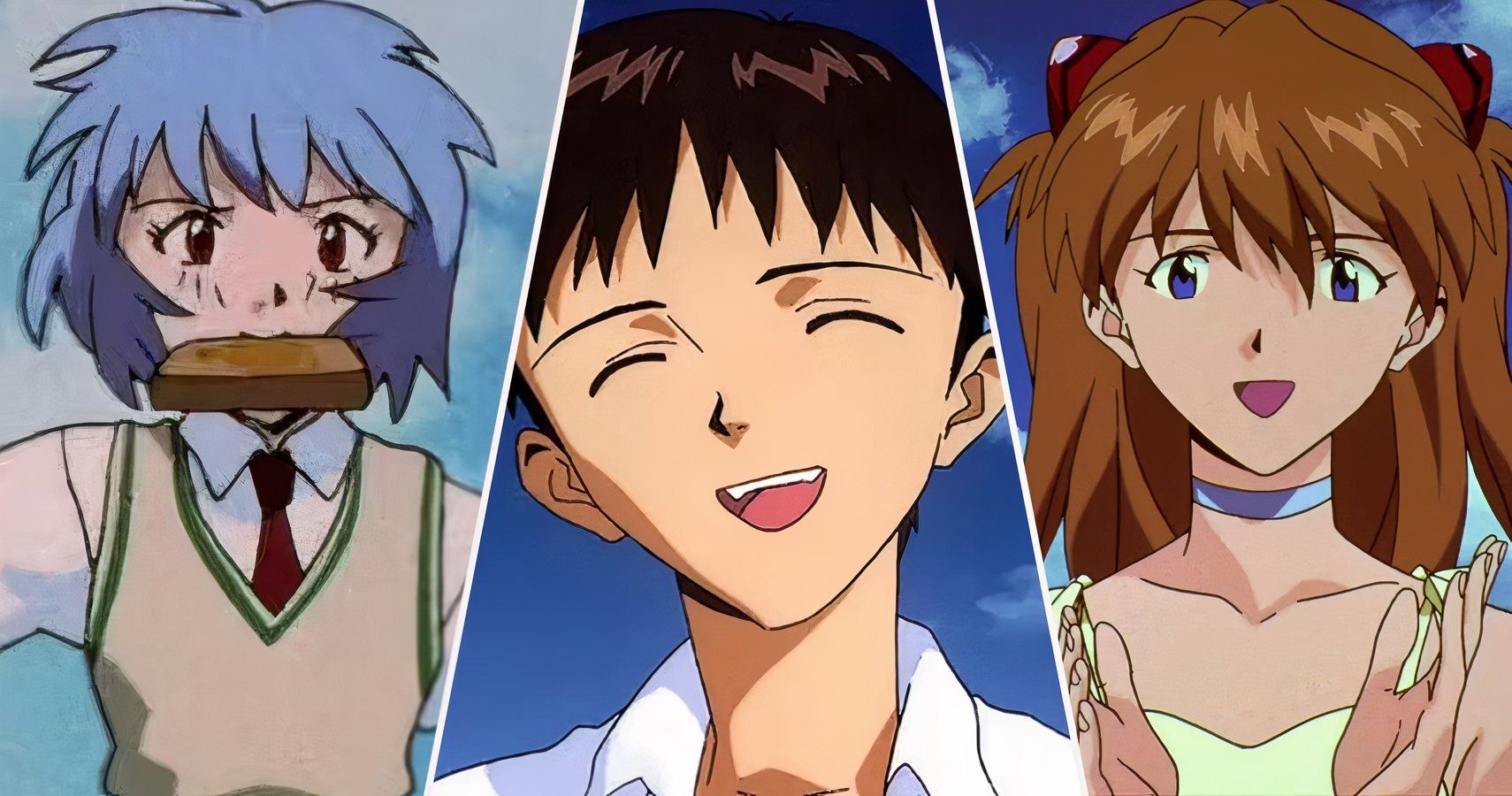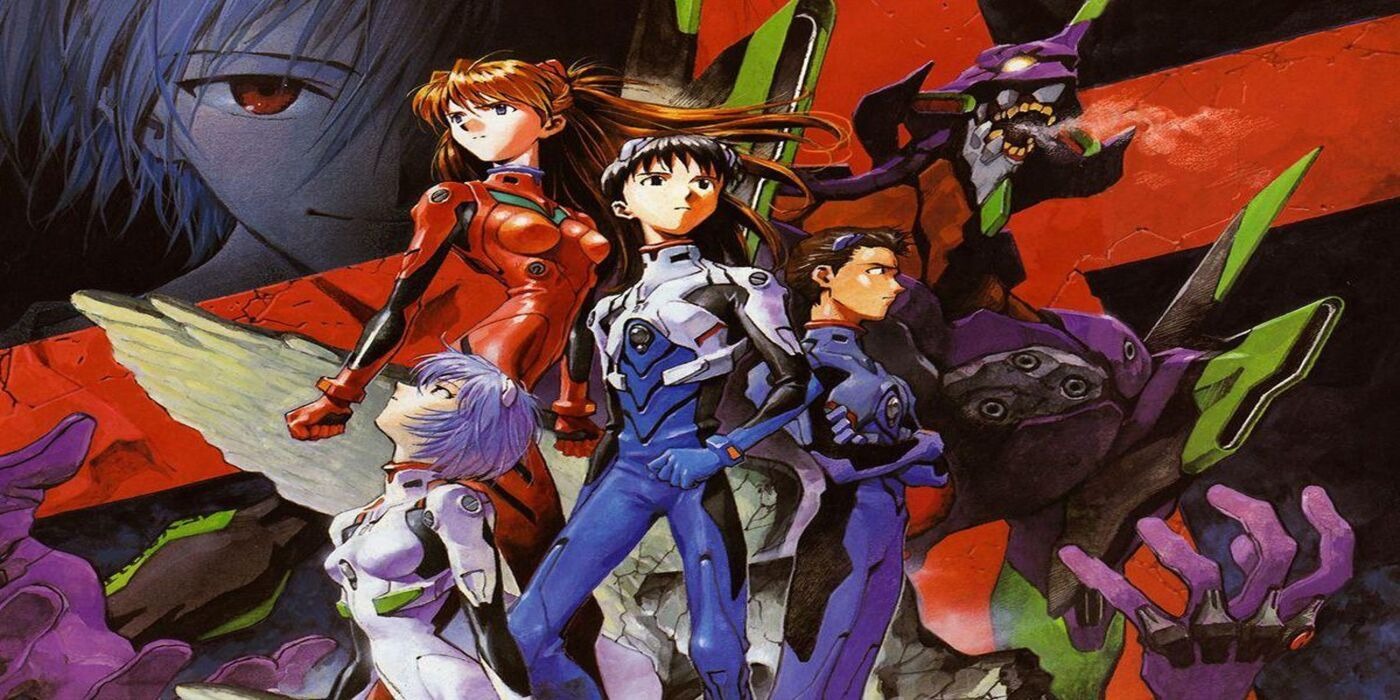Until the last two episodes, Evangelion follows a storyline that is relatively easy to understand. But from episode 25, the structure of the show takes a different turn, switching to a more experimental and abstract approach.
At this point, the Human Instrumentality Project—an idea that has been talked about frequently though never properly broken down—is finally activated. The idea behind Instrumentality in Evangelion is to eliminate the “AT Fields” that surround every individual soul, keeping each one separate from others.

These are the same barriers used by the EVA units as a defense against the Angels, pointing once again to their biological foundation. When this process kicks off, all the minds and souls of people on Earth begin to merge into one shared unconscious space.
The scenes we witness in episodes 25 and 26 take place within this mental setting and not in the physical world, which explains their surreal and dreamlike appearance. Characters like Shinji and Rei start reflecting on the reasons for their existence, asking whether staying apart is worth the emotional pain it brings.
Then in episode 26, Shinji is shown what his life might have looked like if there had never been Evangelions—a peaceful reality where he has friends and a happy family. But this imagined life isn’t something Shinji can fully accept as his reality.
Although it’s not real, it helps him come to terms with the fact that suffering and isolation do not have to define his future. There are alternative paths he could choose beyond the difficult life of piloting an EVA.
This realization pushes him towards accepting both himself and the world around him, and the episode ends with other characters clapping in a circle, congratulating him for this personal growth.
The End of Evangelion Ending Explained
The Big Screen Brought an Action-Packed End to Evangelion
When The End of Evangelion was released as a film, it approached the ending of the anime from a new perspective. The movie is divided into two parts—labeled episode 25′ and episode 26’—and presents what was taking place in the physical world at the same time the mental events of episodes 25 and 26 were going on.
This gives more explanation to the scattered hints of reality seen in the original episodes. After the final Angel is taken down, a confrontation begins between NERV and the secret group SEELE. This happens because Gendo has his version of how Instrumentality should be carried out, and SEELE strongly disagrees.
SEELE sends the Japanese Self-Defense Force to attack NERV HQ, and shortly after, nine mass production EVAs are deployed. Asuka, in her EVA Unit 02, does manage to defeat them at first, but once her unit runs out of energy, the EVAs rise again, overpower her, destroy Unit 02, and take her life.
When Shinji later sees what is left of Unit 02, he realizes that Asuka is no more. At the same time, Rei starts merging with Lilith, the entity hidden underneath NERV HQ.
Rei, being a clone, was created as a suitable human body for Lilith, but instead of granting Gendo his wish, she allows Shinji to take control of humanity’s future by deciding how Instrumentality will happen.
Because of Shinji’s deep resentment towards the world, he allows all AT Fields to vanish, leading to humans dissolving into pools of LCL—the same substance that fills the EVAs. Lilith, who now carries Rei’s look and personality, turns into a massive figure in the movie.
Inside this shared mental state created by Instrumentality, Shinji goes through various memories and has conversations with people like Misato, Asuka, and Rei. None of them can hide their feelings from him anymore.
At a point, he even thinks letting humanity disappear might be better, and Lilith begins absorbing human souls. But the process doesn’t take away the loneliness that Shinji has always felt, and he turns away from it.
This decision makes the AT Fields begin to return, allowing Shinji to rebuild himself as an individual, and Asuka also returns with him. Although human connection is difficult and scary, Shinji chooses to keep trying.
The Rebuild of Evangelion Ending Explained
The Latest Evangelion Movie Goes Down a Very Different Path
The Rebuild of Evangelion movies presents an entirely different continuity, one that moves far beyond the timeline of the original anime. Although much time has passed, Shinji and the other EVA pilots remain the same age because of their involvement with the EVAs.
At the start of the last film, Shinji is battling a deep emotional crisis after seeing Kaworu’s death and spends time healing in a quiet village. There, he bonds with a new version of Rei, who eventually dissolves into LCL, pushing Shinji to face his emotional pain.
This time around, Gendo’s approach to Instrumentality is even more difficult to understand. He activates something called the “Black Moon,” a mysterious vessel that brought Lilith to Earth and had been buried under NERV HQ.
With the Third Impact already behind them, Gendo now aims to start a Fourth Impact to fulfill his vision of Instrumentality. He transforms the Black Moon into two new Spears of Longinus and heads for the site of the Second Impact to begin his plan.
Gendo declares that he has surpassed human limitations, stating that humanity is either going to defeat the Angels or be destroyed. He steps into a strange gateway with EVA Unit 13, followed shortly by Mari and Shinji in Unit 08. Shinji synchronizes with Unit 01 to an infinite level, restoring its full strength.
With this power, Shinji takes one of the Spears from Gendo and changes it. Inside this space where normal physical rules do not apply, father and son face off in a final conflict for the destiny of humanity. Gendo then reveals the presence of an imaginary EVA called “Evangelion Imaginary,” which only exists in this alternate space.
He wants to use it to rewrite reality and carry out Instrumentality differently. Shinji tries to understand Gendo for the first time instead of opposing him blindly. They both realize that their loneliness and inability to connect have been the same.
Eventually, Shinji’s empathy reaches Gendo, who apologizes and vanishes. While still in that imaginary dimension, Shinji decides to allow the world to continue but to remove the existence of Evangelion from it. Using Unit 13, the spirits of Gendo and Yui make Shinji’s wish come true.
The film closes with the grown-up versions of the EVA pilots, suggesting that they never became pilots in this new reality. Shinji appears to be together with Mari, and the last scenes show real-life footage from creator Hideaki Anno’s hometown, open to personal interpretation.
The Neon Genesis Evangelion Manga Ending Explained
Although Evangelion started as an anime, a manga version was developed to go along with it. This version, which ran from 1994 until 2013, includes most of the major events from the show but ends the story in a completely different way.
The manga picks up from the events covered in End of Evangelion and the final episodes but changes key story points. Because the personalities and growth of the manga characters differ from the anime versions, their choices at the end vary too.

For instance, Shinji enters Unit 01 much earlier and manages to save Asuka from dying at the hands of the Mass Production EVAs—something that did not happen in the film.
In the final volume, just like in the film, a massive version of Rei appears and begins to fulfill what seems like Shinji’s wish: a world where the separation between people no longer exists. But Shinji suddenly refuses to go along with this, breaking his mental connection with Rei.
He argues that Instrumentality is no better than death. Even when Rei tells him that going back to individual lives would bring back emotional pain, Shinji accepts this, saying that without that pain, moments of happiness wouldn’t feel real.
As Rei’s giant form starts to collapse and Instrumentality comes undone, the Mass Production EVAs fall back to Earth and are destroyed. Shinji bids farewell to Rei, who thanks him for being her friend.
Inside Unit-01, Shinji then sees what looks like an island emerging from the water, where his mother and later his father are waiting for him. Yui promises that she will always look after him, and Shinji says goodbye to both parents.
The world doesn’t go back to the way it was right before Third Impact. Instead, things reset to the state of life before Second Impact, removing the damage caused by it and returning normalcy to Earth. The red oceans are gone, seasons have returned to normal, and there are no Angels or Evangelion anymore.
Shinji is seen living with his uncle and traveling to Tokyo. The only reminder of what happened is the fossilized Mass Production EVAs, which people now treat as strange old statues. Shinji meets Asuka again at a train station, but it is not clear whether she remembers him.
It appears that Shinji is the only one with memories of the past world. But this Shinji is no longer weighed down by fear and isolation—he is now someone who has found hope and a reason to go on.
The manga’s conclusion has divided fans, with some rejecting it for using what feels like a reset switch that makes earlier events seem pointless.
Others believe the ending is too cheerful for a story like Evangelion. Still, many appreciate the detailed development of characters in the manga and feel that this ending is more fitting for that version of the story. Looking for a thought-provoking drama to watch this weekend Find it now on Netflix.



